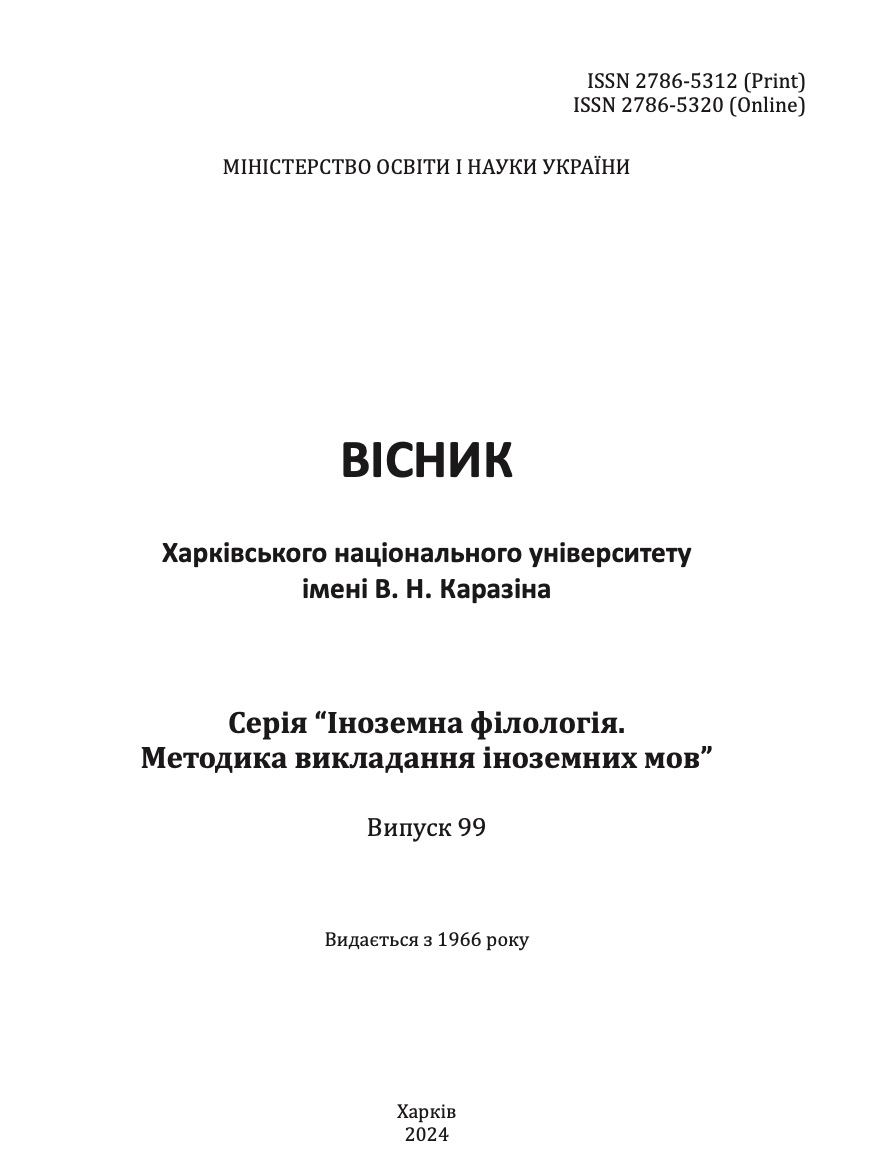Інтеграція трансмедіа в процес навчання іноземних мов: можливості та виклики
Анотація
Статтю присвячено дослідженню способів використання трансмедійних технологій на заняттях з іноземної мови. Питання залучення студентів до навчального процесу в дистанційному форматі, підтримки в них інтересу і мотивації до навчання потребують відповідей і пошуку нових можливостей. Саме це і визначає актуальність цього дослідження. Метою дослідження є визначення специфіки використання трансмедійних технологій для навчання фахової іноземної мови в ЗВО. Об’єктом дослідження є феномен трансмедіації та відповідні технології в освіті, а предметом – способи використання трансмедійних технологій на заняттях з англійської мови. Ретельний аналіз використання сучасних медійних технологій освітянами різних країн доводить невелику кількість розроблених методик навчання іноземних мов на основі трансмедійних технологій. В статті проаналізовано переваги використання трансмедіа в навчальному процесі і їх вплив на результати навчання. Приклади трансмедійних завдань та проєктів, що можуть використовуватись на заняттях з іноземної мови доводять, що ефективність трaнсмедіа обумовлена різноманітними можливостями вдосконалення мовленнєвих навичок читання, говоріння. аудіювання та письма, а також розвитку комунікативних компетентностей студентів засобами трансмедіа. Автори, однак, наголошують на певних викликах, пов’язаних головним чином з недостатньою трансмедійною грамотністю викладачів. Вдосконалення цифрових навичок, що виходять за межі базових знань, є необхідною умовою для ефективного впровадження трансмедійних технологій.
Завантаження
Посилання
Vezhnevets’, I. L. (2019). “Muzychnyj portret” iak khudozhnia forma frantsuz’koi vokal’noi kul’tury KhKh stolittia. (Dys.kand. mystetstvoznavstva). [“Musical portrait” as an artistic form of twentieth-century French vocal culture (Art PhD thesis)]. Natsional’na akademiia kerivnykh kadriv kul’tury i mystetstv, Kyiv. (in Ukrainian)
Zhenchenko, M. I. (2013). Poniattia ‘mul’tymedia’, ‘kros-media’, ‘transmedia’ u naukovomu dyskursi tsyfrovoi doby [The concepts of ‘multimedia’, ‘cross-media’, ‘transmedia’ in the scientific discourse of the digital age]. Naukovi zapysky Instytutu zhurnalistyky, 52, 72-75. Retrieved from: http://nbuv.gov.ua/UJRN/Nzizh_2013_52_12 (in Ukrainian).
Stiekol’schykova, V. A. (2020). Videostoritelinh iak efektyvna model’ ta forma u strukturi iakisnoho investyhejtornoho material [Video storytelling as an effective model and form in the structure of high-quality investment-generating material]. Vcheni zapysky TNU imeni V. I. Vernads’koho. Seriia: Filolohiia. Sotsial’ni komunikatsii, 31(70), № 3, 174–177. (in Ukrainian)
Tymchuk, L. (2017). Teoretyko-metodychni zasady proektuvannia tsyfrovykh naratyviv u navchanni majbutnikh mahistriv osvity (Avtoreferat doktorskoi dysertatsii) [Theoretical and Methodological Foundations of Designing Digital Narratives in the Education of Future Masters of Education (Doctor of Sciences synopsis)]. Instytut informatsiinykh tekhnolohii i zasobiv navchannia NАPN Ukrainy, Kyiv. (in Ukrainian)
Caceda, A. & León, V. (2022). YouTube and Transmedia Storytelling on Educational Marketing of a Business School in Perú. Proceedings of the 2022 International Conference on International Studies in Social Sciences and Humanities, 50-64. http://doi.org/10.2991/978-2-494069-25-1.
Derbaix, M., Bourgeon, D., Jarrier, E. & Petr, Ch. (2017). Transmedia Experience and Narrative Transportation. Journal of Marketing Trends, 4(2), 39-48.
Eder, J. (2015). Transmediality and the politics of adaptation: Concepts, forms, and strategies. In Hassler-Forest, D. & Nicklas, P. (Eds.) The politics of adaptation (pp. 66–81). Basingstoke: Palgrave Macmillan.
Fleming, L. (2013). Expanding Learning Opportunities with Transmedia Practices: Inanimate Alice as an Exemplar. Journal of Media Literacy Education, 5(2), 370–377 https://doi.org/10.23860/jmle-5-2-3.
Freixa, P., Sora-Domenjó, C. & Soler-Adillon. J. (2022). Webdocs: social interaction and transmedia. In Freixa, P., Codina, L., Pérez-Montoro, M. & Guallar, J. (Eds.). Visualisations and narratives in digital media: methods and current trends. Barcelona: Universitat Pompeu Fabra, Ediciones Profesionales de la Información (pp. 82-100). http://doi.org/10.3145/indocs.2022.6.
González-Martínez, J., Esteban-Guitart, M., Rostan-Sanchez, C., Serrat-Sellabona, E. & Estebanell-Minguell, M. (2019). What’s up with transmedia and education? A literature review). Digital Education Review, 36, 207-222. Retrieved from: https://revistes.ub.edu/index.php/der/article/view/26784.
Herrero, C. (2022). Applications of transmedia practices and open educational resources in higher education. Materials of the conference ‘Visual Literacy and Digital Communication: the role of media in new educational practices’ 18–19 December, Madrid: Facultad de Filologia, 43–60.
Jenkins, H. (2003). Transmedia storytelling moving characters from books to films to video games can make them stronger and more compelling. MIT Technology Review. Retrieved from: https://www.technologyreview.com/2003/01/15/234540/transmedia-storytelling/.
Jenkins, H. (2006). Convergence Culture: Where Old and New Media Collide. New York: NYU Press. Retrieved from: http://www.jstor.org/stable/j.ctt9qffwr.
Jenkins, H. (2009). Confronting the Challenges of Participatory Culture: Media Education for the 21st Century. Cambridge: MIT Press.
Ketzer-Nöltge, A. (2024). Potentials of immersive digital learning environments – teaching and learning languages in 360° and VR. Каразінські читання: Людина. Мова. Комунікація: матеріали наук. конф. з міжнар. уч. 02 лютого. Харків: ХНУ імені В.Н Каразіна, 45.
Kinder, M. (1991). Playing with Power in Movies, Television, and Video Games: From Muppet Babies to Teenage Mutant Ninja Turtles. Berkeley and Los Angeles: University of California Press.
Lynch, D. (2016). Between the network and the narrative: transmedia storytelling as a philosophical lens for creative writers. New Writing, 13:2, 161–172. https://doi.org/10.1080/14790726.2016.1170858.
Özbölük, T. (2018). The Marketer as Storyteller: Transmedia Marketing in a Participatory Culture. In Yilmaz, R., Nur Erdem, M. & Resuloğlu, F. (Eds.). Handbook of Research on Transmedia Storytelling and Narrative Strategies (pp. 310–329). Ankara: IGI Global.
Poda, Т. (2021). Storytelling as a modern communication phenomenon. Proceedings of the National Aviation University. Philosophy. Cultural Studies: collection of scientific papers, 2 (34), 102–107.
Sánchez-Caballé, A. & González-Martínez, J. (2023). Transmedia learning: fact or fiction? A systematic review. Culture and Education, 35(1), 1–32. https://doi.org/10.1080/11356405.2022.2121131.
Scolari, C. A. (Ed.). (2018). Teens, media and collaborative cultures: exploiting teens’ transmedia skills in the classroom. Barcelona: H2020 TRANSLITERACY Project. Retrieved from: https://transmedialiteracy.org/.
Scolari, C. A., Masanet, M.-J., Guerrero Pico, M. & Estables, M.-J. (2019). Transmedia Literacy in the New Media Ecology. An International Map of Teens’ Transmedia Skills. Pittsburgh, PA: ETC Press. http://doi.org/801.10.3145/epi.2018.jul.09.
Vorobyova, O. (2022). Multimodality and transmediality in Kamal Abdulla’s short fiction: a cognitive-emotive interface. Cognition, Communication, Discourse, 24, 91-102. http://doi.org/10.26565/2218-2926-2022-24-07.




